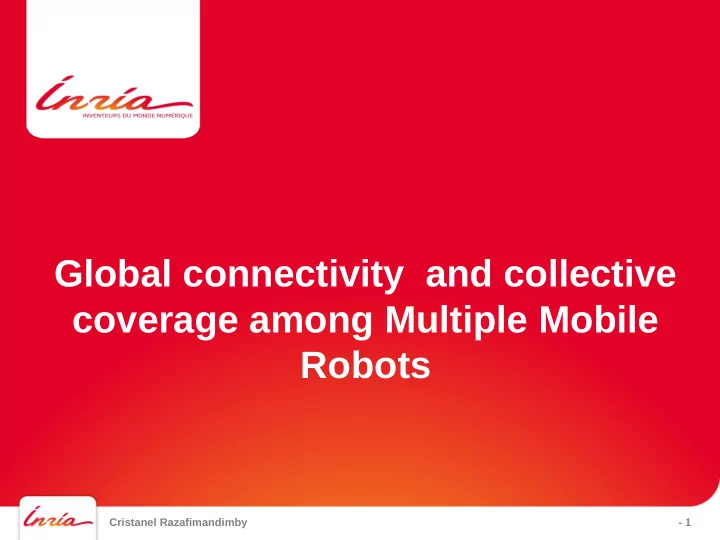

Global connectivity and collective coverage among Multiple Mobile Robots Cristanel Razafimandimby - 1 - 1
SOMMAIRE 1. Context and problematics of my thesis 2. Ongoing works 3. Conclusion Cristanel Razafimandimby - 2 - 2
1 Context & problematics Cristanel Razafimandimby - 3
Context • Ubiquitous and pervasive networks became a reality • Ubiquitous and pervasive networks are composed of heterogeneous devices ( sensors, robots, Smartphones, Laptops, …) • New challenges/opportunities due to the heterogeneity of devices Cristanel Razafimandimby - 4
Problematics • How to make the devices able to communicate to each other • How to allow the devices split the tasks/sub-tasks and agree on the assignement of the tasks in order to reach a common goal • How to make the devices smart Cristanel Razafimandimby - 5
2 Ongoing works Cristanel Razafimandimby - 6
Global connectivity and collective coverage among multiple mobile robots Cristanel Razafimandimby -7
Context • To carry out cooperative tasks, robot team members need to communicate with each other • Maintaining connectivity among multiple mobile robots is a crucial issue Cristanel Razafimandimby - 8
State of art Approaches in literature can be classified into two groups : • Local connectivity maintenance • Global connectivity maintenance Cristanel Razafimandimby - 9
Local connectivity maintenance The initial set of edges which define the graph connectivity must be always preserved over time. Cristanel Razafimandimby -10 -10
Global connectivity maintenance Allows suppression and creation of some edges as long as the overall connectivity of the graph is conserved. Cristanel Razafimandimby -11 -11
Some strategies of connectivity maintenance • Construction of an spanning tree • Maximize the algebraic connectivity • ... Cristanel Razafimandimby - 12
Connected graph • Multi-robot systems can be modeled as an undirected graph G= (V,E) Definition 1 : A graph G is said to be connected if and only if u,v V, there exists a path p(u,v) ∀ Cristanel Razafimandimby -13 -13
Spanning tree (ST) Definition 2 : A spanning tree of an undirected graph G is the subgraph G* = (V,E*) such as : - There is no cycle in G* - |E*| = n -1 Corollary 1 : The graph G is connected if and only if there exists a ST deduced from G. Cristanel Razafimandimby -14 -14
Laplacian matrix and algebraic connectivity - Given a undirected graph G, its Laplacian matrix L is defined as: L(G) = D(G) – A(G) - The scalar λ is an eigenvalue of L if there exists a non-zero vector w such that : L.w = λ.w The Laplacian matrix L(G) holds some interesting properties: 1- The eigenvalues of L(G) can be ordered such that: 0 = λ1 ≤ λ2 ≤ λ3 ≤ …. ≤ λn 2- λ2 > 0 if and if only the graph G is connected. λ2 is called also algebraic connectivity of the graph G Cristanel Razafimandimby -15 -15
Trade-off between collective coverage and communication quality - Maximizing the connectivity is important to ensure reliable communication - Maximizing the collective coverage is needed - Maximizing these two parameters simultaneously is difficult (if not impossible) : maximize collective coverage may lead poor communication quality and conversely - Need to capture the trade-off between collective coverage and communication quality Cristanel Razafimandimby -16 -16
Proposed approaches • Centralized approach for global connectivity maintenance • Distributed trained neural network controller Cristanel Razafimandimby - 17
Centralized approach to maintain global connectivity between robots to a desired quality level • Use of a modified version of virtual force algorithm (VFA) to control the robots' motion • Compute algebraic connectivity metric to guarantee global connectivity maintenance (Centralized computation) • Only move to the new position if λ2 is greater than zero Cristanel Razafimandimby - 18
Obtained results with 5 robots [EVFA] Jun Li & All, An extended virtual force-based approach to distributed self-deployment in mobile sensor networks Cristanel Razafimandimby - 19
Obtained results with 5 robots [EVFA] Jun Li & All, An extended virtual force-based approach to distributed self-deployment in mobile sensor networks Cristanel Razafimandimby - 20
Maintain global connectivity between robots to a desired quality level using Neural Network • Mimic the behaviors of the previous approach • Data set was obtained by using our previous approach • Inputs : distance and angle between two robots i,j • Ouput : new position of robot i according its neighbor j • Training algorithm : backpropagation Cristanel Razafimandimby - 21
Obtained results with 5 robots Cristanel Razafimandimby - 22
Obtained results with 5 robots Cristanel Razafimandimby - 23
3 Conclusion Cristanel Razafimandimby - 24
Conclusion • Working on distributed communication and cooperation among heterogeneous devices • Contribution on global connectivity maintenance and collective coverage among multiple mobile robots • Two proposed approaches till now: Centralized approach based on algebraic connectivity and VFA ● Distributed approach based on neural network ● Cristanel Razafimandimby - 25
Conclusion • The proposed approaches tried to capture the trade-off between network coverage and communication quality • The proposed algorithms allows the whole robot network converges to the desired distance/communication quality • The proposed approaches outperform EVFA in terms of: Traveled distance ● Convergence time ● • O ur proposed methods always maintain the global connectivity • Next step : add some heterogeneity in the system Cristanel Razafimandimby - 26
Merci
Recommend
More recommend